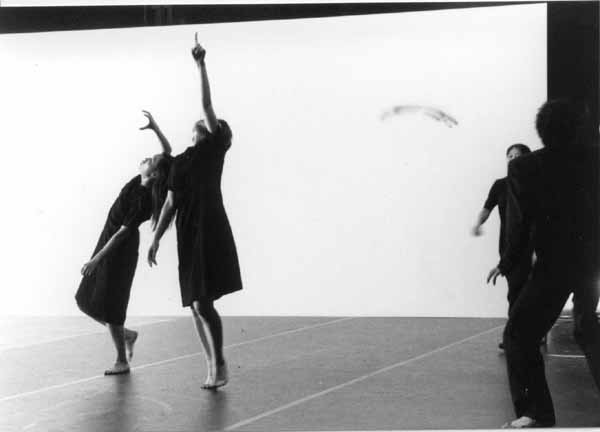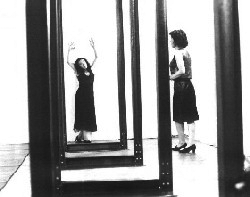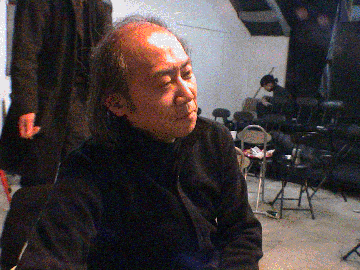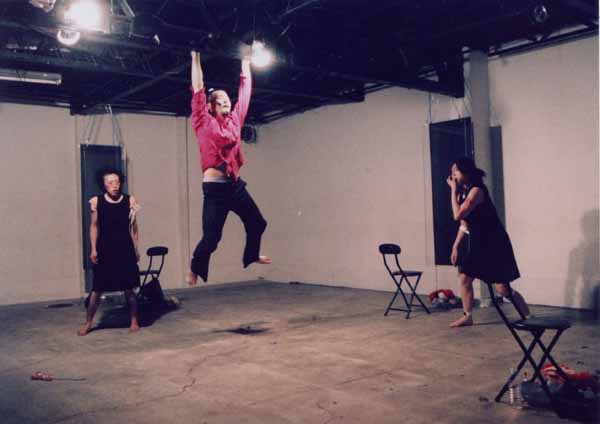
¡½DA-M
In 1986, after eight years of organizing a theater, director Hiroshi
Ohashi along with some actors of this group established Theater D-AM.
The name DA-M has no particular meaning but it is an unknown code for
the audience and the performers. It is the motivation of DA-M to ask
what DA-M is. DA-M acquired the theater space ¡§Proto-Theater¡¨ and organizes
body/mind training year round. They are energetically creating experimental
work in collaborating with artists of diverse disciplines throughout
the world. They consistently refuse to enact an existing text and create
a stage experience that reaches beyond the limits of language. Their
works are composed with fragmented movement, voices and words made by
the body in the here and now. Proto-Theater has been utilized for various
workshops and solo and
collaborative performances, and its creative environment has also contributed
to interactivity between unknown art fields. Since 1995 DA-M began to
perform outside of Proto-Theater in various theater spaces and at international
theater festivals. Through deepening their method of improvisational
body movement, they create stages filled with uncertain life that exists
beyond meaning and that does not belong to the consumer system of the
big city. Critics have praised their theatrical creativity that moves
towards the unknown while mixing the primitive with the modern. As a
major participant of the Asia Meets Asia International Theater Festival
since 1997, DA-M has contributed to the developing interactivity between
Asian theaters.
1986 ¡§HARE HORE FURARA¡¨ at TOGA International Theater Festival.
1986 ¡§Sanctuary,¡¨ Japanese and American co-production.
1989?1992 ¡§Composition¡¨ Vol. 1 ? 12.
1992? 1995 ¡§Experimental Theater Series¡¨ Vol. 1 ? 22.
1994?1995 ¡§Dreams¡¨ Vol. 1 ? 3.
1995 ¡§That is not my dream¡¨ at Sendai Theater Festival.
1996 ¡§Lesson ? My portrait that is framed by the dream¡¨
1997 ¡§walking¡¨ at Avignon Theater Festival Off.
1998 ¡§Daydream Horizon Impro.¡¨ at Asia Meets Asia 1998.
1999 ¡§Il Vulcano¡¨
¡§Unbearable Dream,¡¨ co-production with Hong Kong theater
2001 ¡§When we stop eating tomatoes¡¨ at Asia Meets Asia .
¡§When we stop eating tomatoes¡¨version3 at Kampnagel, Humburg. Laokoon
Summer Festival
2003 ¡§Unbearable Dream¢±¡¨ co-production with Hong Kong-based heater
and Taipei-based theater, in Tokyo & Taipei.
2004 ¡§aruku¡¨ at Arts Festival ¡§Peace and Respect¡¨ in Kyrgiz.¡@
2004 ¡§aruku¡¨ at Art Summit Indonesia in Indonesia.¡@
2005¡@"Happy Birthday" callaboration work with Hong Kong artists
http://homepage3.nifty.com/da-m/index.htm


¡½HIROSHI OHASHI started his theater career while he was in college. In 1978 he founded Waseda Shin Gekijo Theater and became its artistic director. He has produced and directed 20 theater works in unconventional performance spaces that include tents, abandoned houses, and music clubs throughout Japan. His deconstructions of the texts of Shakespeare, Wilde, and Beckett created a totally new stage experience--full of irrational laughter and madness combined with a sharp critical perspective. Both audiences and critics have praised these productions. In 1986 he dissolved Waseda Shin Gekijo Theater and with some of its actors founded DA-M, which aims to create performance that reaches beyond modern theater practice in an adventure into the unknown. After living in New York for a brief period in 1987 and 1988, he has been continuously presenting experimental works based at DA-M¡¦s Proto-Theater.¡@He is developing a new, theatrical creative power that confronts contemporary questions. His method is not based in conventional theater practice but combines a Japanese sense of the dynamic body with a quality of ¡§irreproducibility¡¨ that is evident in modern paintings and music. Since establishing DA-M he has produced and directed more than 90 theater pieces including many collaborative works with artists from diverse fields. He also teaches at various schools and universities. Since 1997 he has organized Asia Meets Asia International Theater Festival in Tokyo, which has contributed to the development of the intercultural movement between Asian theaters.

¡½¨ó¤t®ü¨½¡@Kairi Wakikawa
Director of IMAGEIOERA, he is a Buto
dancer who learned from Kazuo Ohno, Akira kasai, who are very famous
all over the world.
Kairi is very interested in the text(words), and he is thinking of how
to creat new dance with the text which has critical elements for the
modern society civilization.
He found IMAGEIOERA, a dance company, 2003,Tokyo. He has been seeking new forms of body language and metamorphosis from conventional mindset of physicality. His recent work The Oil Field II which was projected as a criticism allegorically (or like cursing) against the highly developed capitalism. It was inspired by an Italian aster, Paolo Pasolini's past works. From Pasolini viewpoint, the consumerism society is a truly intolerable fascism. But the capitalism is more and more developing around the world. Is it impossible to re-design another world model alternatively? How could the future be, if only for hedonism? . Whatever the answers could be, we are gasping, seeking for pleasure and despairing faraway from the triangle of Africa, Europeand America.

